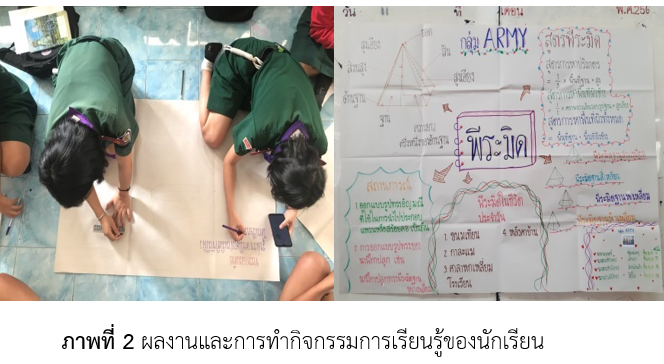The development of learning implementation based on context-based learning approach in surface area and volume topic to enhance mathematical representations for grade-9 students
Main Article Content
Abstract
The purposes of this research were to study: 1) the appropriate learning implementation based on Context-Based Learning (CBL) approach that enhance mathematical representations, and 2) the effect of learning implementation based on CBL on mathematical representations in surface area and volume topic for grade-9 students. This research was conducted in the first semester of the academic year 2019. The research sample was 23 grade-9 students from a medium sized school in Tak Province. The research applied classroom action research and took 17 hours for learning implementation. The research instruments included five lesson plans, worksheets, and mathematical representations. The data were analyzed by content analysis and the data acquired will be checked for trustworthiness by resource triangulation technique; and data were analyzed by analytic scoring. The findings of the study indicated that the learning implementation based on CBL approach to enhance mathematical representations should emphasize on the mathematics problem solving situations that should be more concerned in context of Karen students’ real life, checking students’ new knowledge before giving them the inexperienced situations. Moreover, the teacher should encourage students to draw 3D shapes into a geometric model, to do hands on activities, to use mathematical representations in problem solving. When they presented in front of the class, teacher should give them a chance to exchange ideas with friends and sometimes let them presented in Karen in order to increase their understanding, and ask them to give example of situations that related to real life. In addition, most students can express their mathematical representations in a good level. They can determine the related variable in given situation and write in form of mathematical model that apply to solve the problem. Furthermore, the students can use the appropriate formula and proceed to solve the problem well.
Article Details

This work is licensed under a Creative Commons Attribution-NonCommercial-NoDerivatives 4.0 International License.
The Journal of Science and Science Education (JSSE) retain the right of all articles published in JSSE. The coresponding author or the authorized person on behalf of the authors must send the complete Copyright Transfer Form to JSSE before any article get published in JSSE.
Copyright Transfer Form
The JSSE request the coresponding author or the authorized person on behalf of the authors upload the manuscript under the together with the Copyright Transfer Form under the supplementary data. The guidline for uploading both manuscript and Copyright Transfer Form is shown below:
1. Upload the manuscript in the sub-menu, Article Component > Article Text.
2. Upload the the Copyright Transfer Form in the sub-menu, Article Component > Other.
Download Copyright Transfer Form
References
Boonsri, J. (2012). Construction of Mathematics Instructional Handbook Connecting with Hill Tribe Artifacts, Suksasongkroh Chiang Dao School, Chiang Mai Province (in Thai). Master’s Thesis. Chiang Mai: Chiang Mai University.
Crawford, M.L. (2001). Teaching contextually: research, rationale, and techniques for improving student motivation and achievement in mathematics and science. Texas: CCI Publishing.
Gillbert, J.K. (2006). On the nature of “context” in chemical education. International Journal of science Education, 28(9), 957-976.
Klaynil, S. (2015). Thai science education: Development and recession. (in Thai). Samut Prakan: Advance Printing Service Company Limited.
Kemmis, S., & McTaggart, R. (2000). Participatory action research. In N. Denzin & Y. Lincoln (Eds.), Handbook of qualitative research (2nd ed., pp. 567–605). Thousand Oaks, CA: Sage
Lhongruk, W. (2010). The effects of developing contextual learning activities in “statistics” on academic achievement, mathematical connection skills and communication skills of Mathayomsuksa V student (in Thai). Master’s Thesis. Bangkok: Srinakharinwirot University.
National Council of Teacher of Mathematical (NTCM). (2000). Principles and standards for school mathematics. Reston, Virginia: NTCM.
National Institute of Educational Testing Service (Public Organization). (2018). Summary of the national basic educational testing (O-Net), grade 12, Academic year 2017. Retrieved 12 April 2017, From NIETS: http://www.newonetresult.niets.or.th/AnnouncementWeb/Login.aspx?ReturnUrl=%2fAnnouncementWeb%2fSchool%2fReportSchoolBySchool.aspx%3fmi%3d2&mi=2
Phatsoongnern, N. and Sahatsathatsana, C. (2019). Development of mathematics learning achievement on linear inequality of one variable for grade-9 students through the use of skill exercise based on constructivist theory (in Thai). Journal of Science and Science Education, 2(1), 1-11.
Pluempitiwiriyawej, K. and Makanong, A. (2019). Development of an instructional process based on mathematical modeling and scaffolding approaches to enhance mathematical problem solving and representation abilities of lower secondary school students (in Thai). Journal of Education Studies, 47(4), 86-107.
Partnership for 21st century skills. (2015). Framework for 21st century skills learning. Retrieved 12 April 2017, from Battelle for Kids: https://www.battelleforkids.org/networks/p21/frameworks-resources
Pramchoo, J., Sritunyoo, A. and Meesook, L. (2010). The effect of using context-based learning activities on Grade-11 Students learning achievement in chemistry (in Thai). Journal of Humanities and Social Sciences, 2(1), 32-41.
Samart, P. (2012). Development of mathematical thinking of eighth grade students by using mathematizing process (in Thai). Master’s Thesis. Bangkok: Chulalongkorn University.


